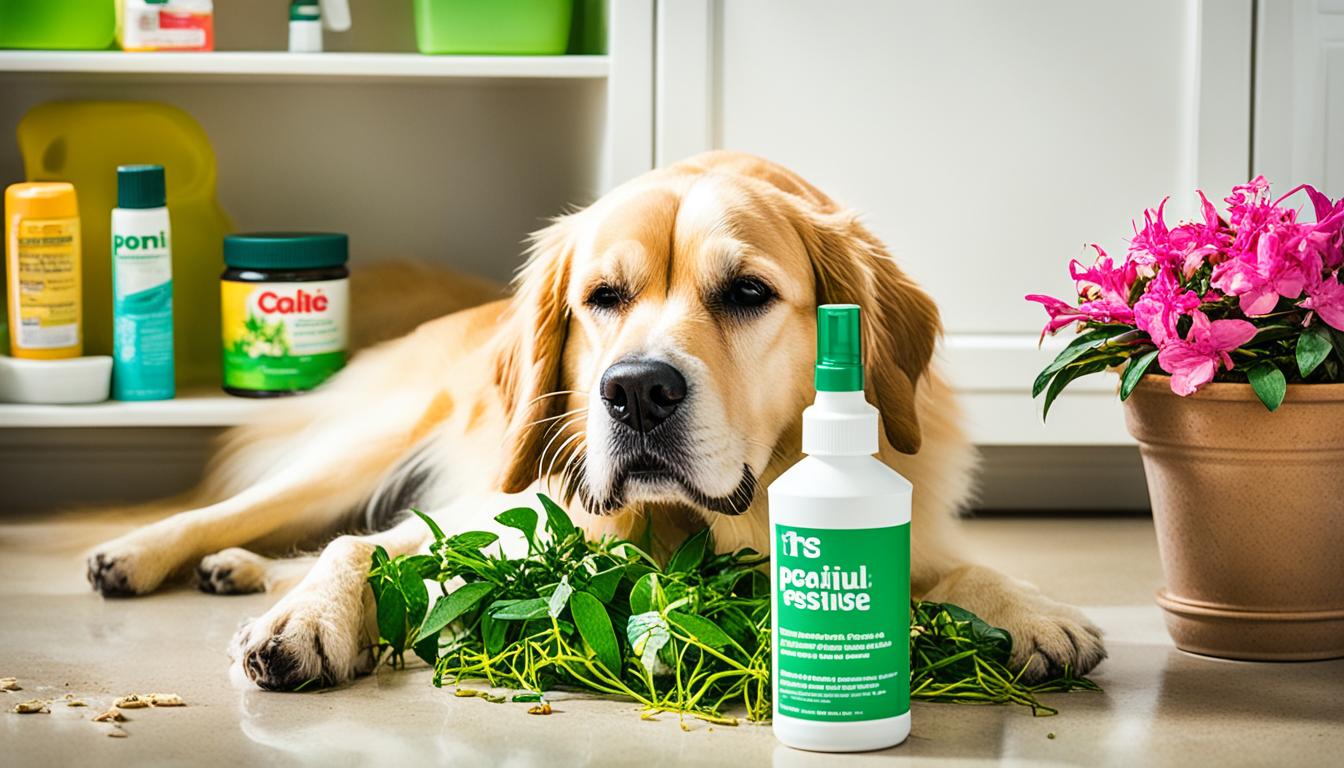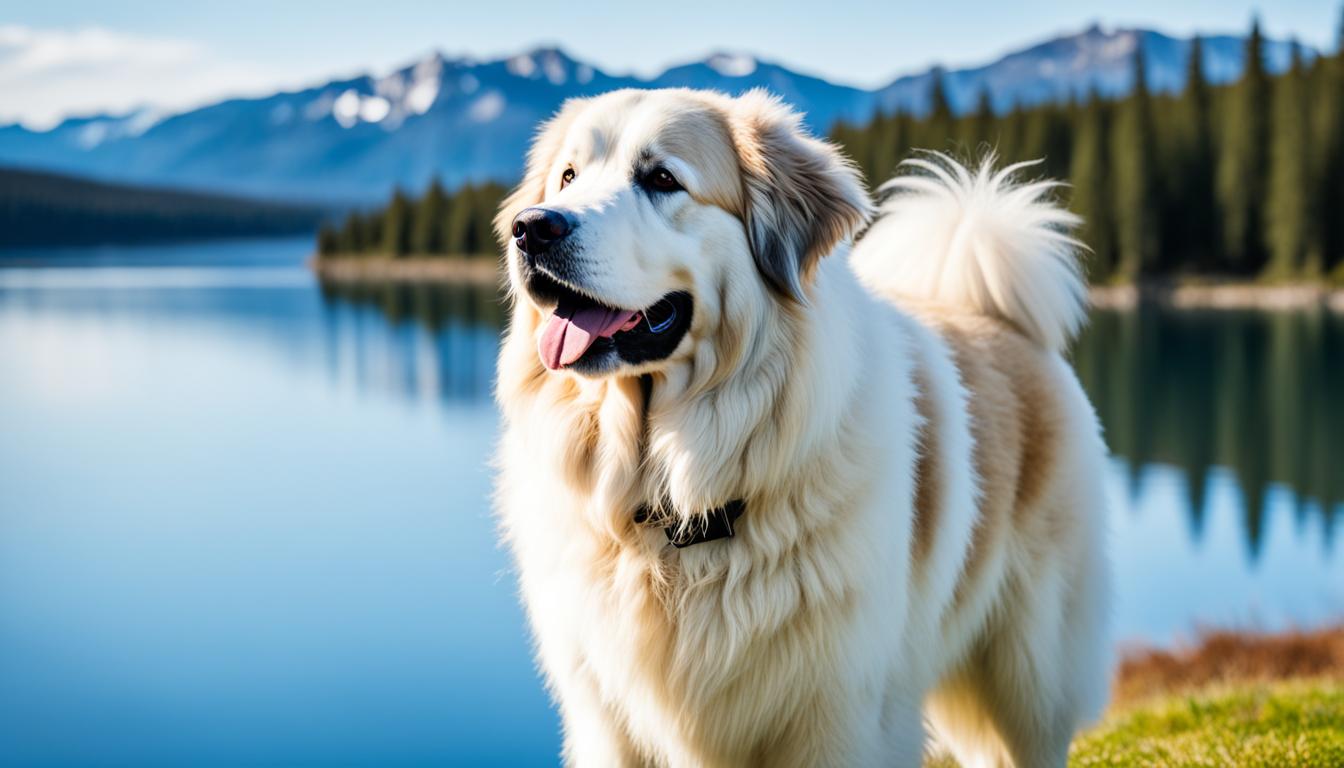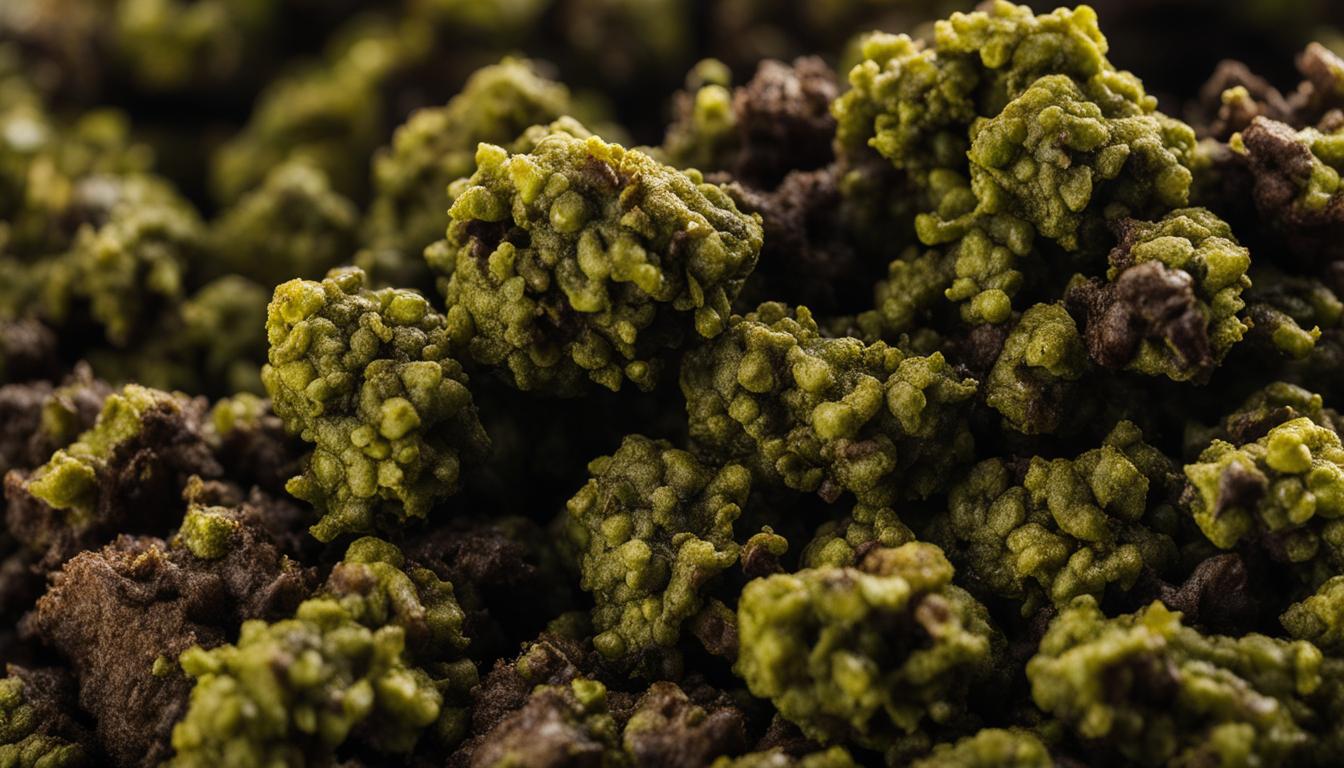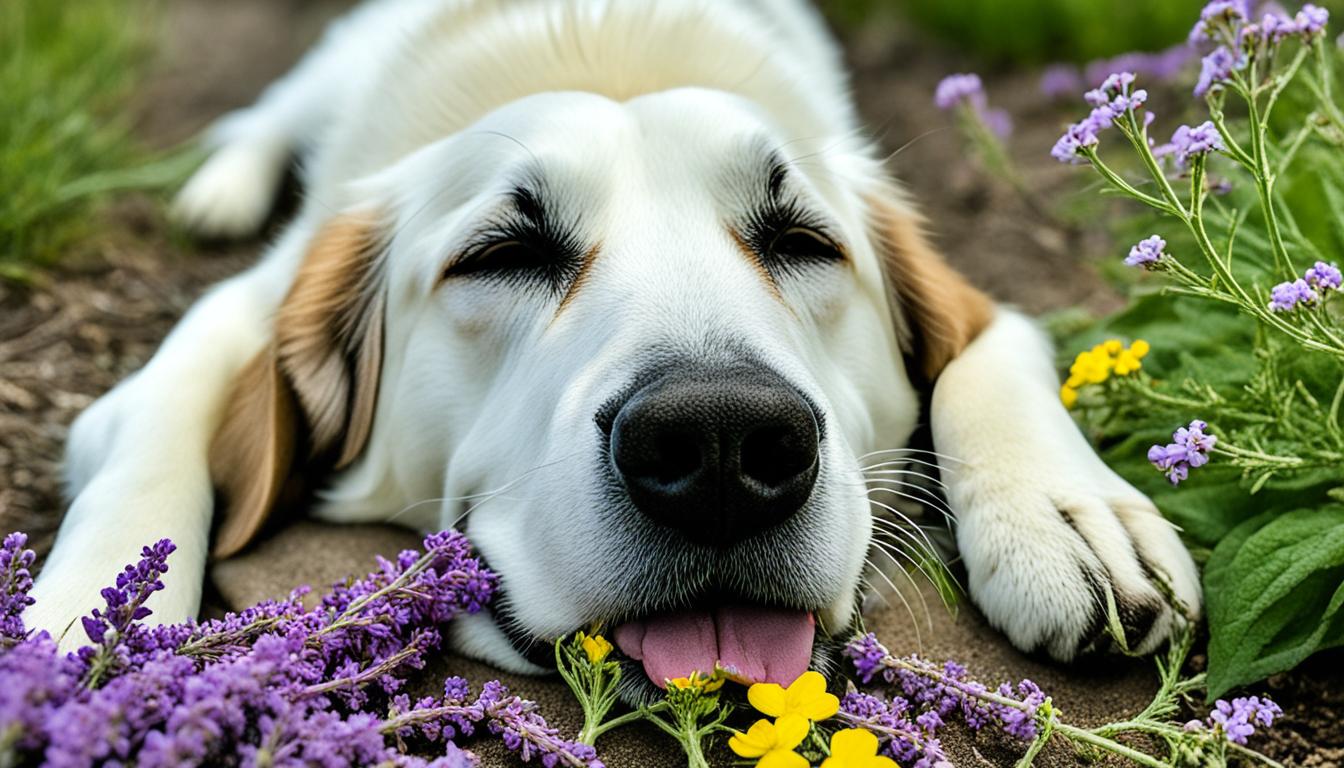Many things we use every day can be dangerous to our dogs. As pet owners, we need to know what can hurt them. Here are some things that can be toxic to dogs.
It’s important to know what to keep away from your dog. What’s safe for us might harm them. Many items at home can be bad if a dog eats them. Keep these things out of reach to keep dogs safe.
This article talks about dangers for dogs, both things they can eat and things they can’t. We’ll cover toxic plants and flowers, toxicity levels, and how to spot poisoning. You’ll also learn how to prevent it and what to do in an emergency.
Key Takeaways:
- Common household items can be toxic to dogs, both edible and non-edible.
- Some foods, drinks, and plants that are safe for humans can be poisonous to dogs.
- The level of toxicity can vary depending on the item and amount ingested.
- Recognizing the signs of poisoning is crucial for prompt treatment.
- Prevention measures such as dog-proofing the home can greatly reduce the risk of poisoning incidents.
Edible Dangers for Dogs
Keeping your dog safe means knowing what they can’t eat or drink. Some human foods and drinks can hurt dogs. It’s vital to stop dogs from eating these dangerous items.
Chocolate is really bad for dogs. It has theobromine, which dogs can’t handle well. Even a little chocolate can make dogs sick, cause rapid breathing, or even seizures.
Alcohol is also harmful to dogs. If dogs drink it, they can get alcohol poisoning. This makes them confused, shaky, and can stop their breathing.
Caffeine is bad for dogs too. It’s in coffee, tea, energy drinks, and some medications. It can make dogs restless, have a fast heartbeat, shake, and have seizures.
Note: Keep dangerous items away from pets to avoid poisoning. Always talk to a vet if your dog eats something bad.
Grapes and raisins can surprise dog owners by being toxic. They can cause kidney failure in dogs. Even a little bit is dangerous. Signs include throwing up, diarrhea, not wanting to eat, and kidney problems.
Avocados, onions, and garlic are dangerous too. They harm a dog’s red blood cells, causing anemia. Signs include weakness, pale gums, and fast breathing.
Xylitol, found in gum and some peanut butter, is very toxic to dogs. It can make their blood sugar drop fast. Signs include throwing up, being weak, not being able to walk straight, having seizures, and liver problems.
Avoiding Harmful Plants for Dogs
It’s not just food. Some plants are bad for dogs too. Dogs can get sick from eating certain plants and flowers.
Lilies are very toxic, especially to cats, but dogs too. Eating any part of a lily can cause vomiting, diarrhea, dehydration, and kidney problems in dogs.
Plants like daffodils, tulips, azaleas, and sago palms are harmful. Eating these can cause drooling, vomiting, stomach pain, and sometimes, organ failure.
Make your home and garden safe for your dog. Get rid of dangerous plants. If you are not sure about a plant, ask a vet what to do.
Note: Prevention is the best way to keep your dog safe from toxic items. Keep dangerous things away from your pet. Always get vet help if your dog eats something toxic.
Non-Edible Dangers for Dogs
Dogs love to explore and often use their mouths to do so. This can lead them to eat things that are not food. These items can be very harmful. Pet owners must know about these risks and protect their pets.
Poisonous Chemicals for Dogs
Many household items have chemicals that are bad for dogs. Dogs can get sick or worse if they eat these. Here are some things to watch out for:
- Antifreeze: It tastes sweet but is very harmful. Even a little bit can hurt a dog’s kidneys or be fatal.
- Cleaning Products: Items like bleach can be dangerous. They can upset a dog’s stomach or be deadly.
- Pesticides: Products to kill bugs and rodents can also harm dogs. They can get sick if they touch or eat these.
- Lawn Fertilizers: Products for green lawns can be bad for dogs. Eating these can cause vomiting, diarrhea, and harm to organs.
- Mothballs: Used to keep insects away but are toxic to dogs. They can cause illness if eaten.
- Batteries: Chewing on batteries can burn a dog’s mouth and be very harmful. Eating batteries is an emergency.
Keep harmful items in secure places away from dogs. This keeps them safe from eating dangerous things.
Pet Safety Hazards
Other items can also hurt dogs. Dogs might chew or swallow things that are harmful. Some items to be careful with include:
- Sharp Objects: Things like needles can injure a dog inside. They can cause bleeding or blockages.
- Small Toys or Parts: These can choke a dog or block their insides.
- Plastic Bags or Packaging: Dogs might chew these but they can block the stomach. This is very serious.
- Electrical Cords: Chewing cords can shock or hurt a dog. It’s especially risky for puppies.
- Heavy Objects: Falling items can injure or crush a dog. This includes furniture or appliances.
Make your home safe for dogs by moving hazards and giving them safe toys.
| Poisonous Chemicals for Dogs | Pet Safety Hazards |
|---|---|
| Antifreeze | Sharp Objects |
| Cleaning Products | Small Toys or Parts |
| Pesticides | Plastic Bags or Packaging |
| Lawn Fertilizers | Electrical Cords |
| Mothballs | Heavy Objects |
| Batteries |
Know the dangers for dogs that aren’t food. Keep your pets safe. Check your home for dangers and teach your dogs what not to eat. This keeps them safe and healthy.
Toxic Plants and Flowers for Dogs
Many plants and flowers make our homes look nice. But, some can hurt our dog friends. We must know which ones are bad and keep our dogs away from them.
Harmful Plants for Dogs:
- Lilies like Easter lilies can harm dogs’ kidneys. A tiny bit of pollen or vase water is toxic.
- Daffodils have parts that can make dogs sick. They can vomit, have diarrhea, and even heart issues.
- Tulips have a bad part called tulipalin A. It can upset dogs’ stomachs and cause big health problems.
- Azaleas and Rhododendrons have grayanotoxins. These can make dogs weak and sick, even hurting their heart.
- Sago Palms are very bad. They have cycasin that can damage the liver and cause seizures or death.
Keep these bad plants away from dogs. Use safe plants instead. This helps keep our dogs from getting sick.
“Keeping our dogs safe should be very important. Knowing about bad plants helps make a good place for them.”
There are more dangerous plants out there. If you don’t know if a plant is safe, ask a vet or plant expert.
We’ll talk about how different things can be toxic. Knowing what to do fast if a dog eats a bad plant is key.
Variation in Toxicity Levels
The level of toxicity in some items can change a lot. This depends on the type of animal, how much was eaten, and which part was eaten. It’s key for dog parents to know these differences. This helps keep their furry friends safe. If a dog eats something bad, getting help fast is vital.
For dogs, different things have different bad effects. Some may only cause a little trouble or discomfort. But others can be very dangerous. Foods like chocolate, grapes, and onions are really bad for dogs. They should be kept away. But little caffeine or some plants might only upset their stomachs a bit.
How bad a toxic thing is can also change with the dog’s breed or size. Small dogs often get sicker because they are little and have different bodies. So, a little bit of something bad can be worse for them than for big dogs.
“It’s important to be aware of the potential for variations in toxicity levels when it comes to dogs.”
Sometimes, what part of the thing the dog ate matters. Some plants have bad leaves or stems. But their flowers or fruits are okay. Knowing this can help pet owners avoid dangers better.
If your dog eats something bad, call a vet or pet poison help right away. They can tell you what to do next. This depends on what was eaten and your dog’s details.
Examples of Variation in Toxicity Levels in Dogs
| Substance | Degree of Toxicity |
|---|---|
| Chocolate | Highly toxic in large amounts; can cause seizures and cardiac issues |
| Caffeine | Mild to moderate toxicity; can cause restlessness and increased heart rate |
| Grapes/Raisins | Highly toxic; can cause kidney failure |
| Onions/Garlic | Moderate to severe toxicity; can damage red blood cells |
| Household Cleaners | Varies depending on the specific product; can cause respiratory and digestive issues |
Knowing about toxicity levels helps dog parents prevent bad accidents and get fast vet help when needed. By being informed and careful, pet owners can make sure their dogs stay safe and healthy.
Acting Quickly in Case of Poisoning
Sometimes, dogs may eat something harmful. Quick action is key to keep them safe.
If you think your dog ate something bad, act fast. Call your vet or a pet poison helpline right away. They have experts to help you.
Key symptoms to watch out for:
Know the signs of poisoning in dogs. Look out for vomiting, diarrhea, extra drooling, or too much thirst. Other signs are trouble breathing, odd behavior, or seizures. Spotting these early helps you act fast.
Quick action is very important. Some things can be very harmful to dogs, even in tiny amounts. Waiting too long can make things worse for your pet.
Emergency pet poison control centers:
In an emergency, poison control centers are very useful. They can deal with poison cases and give you advice quickly. They help you figure out what to do until you see your vet.
The ASPCA runs a poison center for pets that’s open all the time. It’s good to save their number, 1-888-426-4435, in your phone. This way, you can reach them fast if you need to.
Remember, acting fast is crucial for your dog’s health. Quick action and expert advice can make a huge difference. They can help keep your pet safe from harmful poisons.
Common Household Items That Can Poison Dogs
Some common household items can be dangerous to dogs. This includes food, drinks, and plants. Pet owners need to know these dangers and keep their pets safe.
1. Chocolate
Chocolate is very bad for dogs because of theobromine. Even a little bit can make them very sick. Keep chocolate away from your dog.
2. Medications
Medicines for humans can hurt or even kill dogs. Always put medicines where your dog can’t reach them.
3. Cleaning Chemicals
Cleaning products have chemicals that are poisonous to dogs. Keep them in a safe place. Make sure you have fresh air when you clean with them.
4. Toiletries and Personal Care Products
Toothpaste and lotions can harm your dog if they eat them. Store these items where your dog can’t get them.
5. Grooming Tools
Tools like razors can hurt your dog. Keep them put away safely. Make sure your dog doesn’t get them.
6. Children’s Toys
Toys with small parts are unsafe for dogs. Keep them away from your dog to prevent choking.
“It is crucial for pet owners to be vigilant and ensure that their homes are free from toxic household items that could harm their beloved dogs.”
To keep your dog safe, lock away dangerous items. Paying attention to these risks helps keep your dog healthy and safe.
Recognizing Signs of Poisoning in Dogs
As loving dog parents, we must know how to spot poisoning signs. Spotting them early means we can quickly help our dogs. This quick action can save their lives.
Some symptoms to look out for are:
- Digestive upset, such as vomiting and diarrhea
- Pale gums
- Changes in thirst and urination
- Unexplained depression or lethargy
- Agitation or restlessness
- Tremors or seizures
- Difficulty breathing
If your dog shows these signs or might have eaten something bad, get help fast. Acting fast is key to helping dogs recover from poisoning.
Always remember, keeping them safe is better than curing. Making your home safe for dogs and watching out for dangers will help avoid poisoning. This keeps your furry friend happy and healthy.
Prevention Tips for Dog Owners
Keeping your furry friend safe is very important. A few simple steps can lower the risk of dog poisoning. Consider these dog-proofing tips and pet safety measures.
1. Store Toxic Items Out of Reach
Storing harmful items safely is key to preventing poisoning. Use child-proof latches on cabinets. Keep dangerous items on high shelves or locked up.
2. Secure Trash Cans
Dogs often get into the trash, which can be dangerous. Use a dog-proof trash can or place the trash in a safe spot away from your dog.
3. Keep Food and Drinks Out of Reach
Some human foods and drinks are bad for dogs. Always keep them stored where your dog can’t get them.
4. Properly Store Medications and Chemicals
Keep all medicines away from your dog. Also, store house cleaners and yard chemicals safely to avoid accidents.
5. Provide Safe and Dog-Friendly Toys
Give your dog dog-safe toys that aren’t toxic. Choose toys made for dogs or natural safe options for them to play with.
6. Supervise Your Dog’s Environment
Check your home and yard for dangers to your pet. Look for toxic plants and unsafe chemicals. Make sure dangerous items are out of reach.
Using these prevention tips can help prevent poisoning. Making these changes at home makes it safer for your dog.
“Prevention is better than a cure. Dog-proofing your home helps keep your dog safe from dangers and keeps them happy and healthy.”
Safe Alternatives for Dogs
Keeping your pets safe means choosing the right items for them. Use pet-friendly products and safe toys. This helps them stay out of danger while being happy.
Creating a Safe Environment
Choose pet-friendly cleaning items for a safer home. These are gentle for pets and good for cleaning. They are also safe for the environment.
Some indoor plants are not good for dogs. Pick non-toxic plants like spider plants and bamboo palm. These plants are safe and make your home look nice.
Dog-Specific Toys and Treats
Don’t give your dog toys or treats that could be bad for them. Find toys made of rubber or nylon. They are safe for your dog to play with.
Choose treats that are made for dogs. Avoid ones with bad ingredients like artificial colors. Go for natural treats that are both healthy and delicious.
Non-Toxic Household Items for Dogs
| Item | Description |
|---|---|
| Dog-friendly cleaning products | Pet-safe alternatives to harsh chemicals. Gentle on your dog’s skin and respiratory system while effectively cleaning your home. |
| Pet-friendly plants | Non-toxic plants that can add a touch of greenery to your home without posing any harm to your furry friend. |
| Dog-specific toys | Made from safe and durable materials, providing your dog with hours of safe and enjoyable play. |
| Dog-safe treats | Formulated with natural and wholesome ingredients, providing your dog with a tasty and healthy reward. |
By choosing the right items, you make your dog’s life better. Picking pet-friendly products and safe toys helps keep them safe. Your dog will be happy and healthy.
Immediate Action in Case of Poisoning
If your dog eats something dangerous, act fast to avoid more harm. Acting quickly is key when your dog is poisoned. Quick help can really change how things turn out.
First, call your vet or a pet poison control center. They’ll tell you what to do to help your dog. They know all about first aid for dog poisoning and what to do next.
Keep your dog calm and safe while you wait for help. Don’t try to make them vomit or give home remedies unless a pro says so. These could make things worse.
“If your dog ingests something toxic, it’s important not to panic. Stay calm and reach out for immediate help. Time is critical in cases of poisoning.”
When you talk to the vet or poison center, they’ll ask about your dog. Like their breed, weight, and what they ate. This helps them give the best advice.
In some cases, they may tell you it’s okay to make your dog vomit. But only do this if they say it’s safe.
Each poisoning case is different. So, it’s vital to do what your vet or the poison center suggests.
Emergency Treatment for Dog Poisoning
After calling your vet or poison center, they might say to bring your dog in right away. If the poison is really bad, your dog may need quick help from a vet.
The vet will check your dog out, maybe do blood tests and scans. Then they’ll know how to fix the poisoning.
Emergency treatments might be needed, like:
- Giving activated charcoal to soak up the poison.
- Putting your dog on IV fluids to help get rid of the poison and keep them hydrated.
- Giving medicine to help with symptoms and fight the poison.
- In bad cases, they might use special antidotes.
How long and how tough the treatment is depends on what your dog ate and how they’re doing health-wise. The vet will watch your dog closely and change the plan if needed.
The Importance of Dog-Proofing the Home
It’s very important to make our homes safe for dogs. Doing this helps keep them healthy and happy. When we dog-proof our homes, we stop our pets from getting into dangerous things.
First, we must keep harmful items away from our dogs. We should store cleaners, medicines, and other bad things where dogs can’t get them. This stops dogs from eating these items and getting sick.
Also, we need to make our homes safe in other ways. We should keep electrical cords out of reach and put breakable things up high. We must ensure that gates and fences are strong so dogs don’t wander off.
A safe home for dogs also means they get plenty of playtime and things to do. This helps keep them from having accidents or doing things they shouldn’t. We should always watch over our dogs to keep them out of trouble.
By following these steps, we make sure our dogs live in a safe, happy home. These actions lower the chances of dangerous accidents. It means our dogs can fully enjoy their time with us at home.







